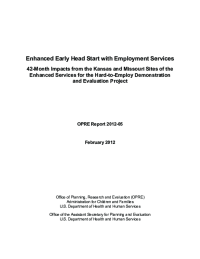Enhanced Early Head Start with Employment Services
42-Month Impacts from the Kansas and Missouri Sites of the Enhanced Services for the Hard-to-Employ Demonstration and Evaluation Project
As part of the multisite Enhanced Services for the Hard-to-Employ Demonstration and Evaluation Project, MDRC, together with its research partners, is leading an evaluation of parental employment and educational services delivered within Early Head Start (Enhanced EHS). The program model tested here aims to dually address the employment and educational needs of parents who are at risk of unemployment and the developmental needs of their children. The study is sponsored by the U.S. Department of Health and Human Services, with additional funding from the U.S. Department of Labor.
The study uses a rigorous random assignment design comparing outcomes for families and children who were offered Enhanced EHS with outcomes for those who could only access alternative services in the community. This report presents the final impact results approximately 42 months after families and children first entered the study.
Key Findings
- Because of implementation challenges, the Enhanced EHS program’s formalized employment, educational, and self-sufficiency enhancements were never fully integrated into core EHS services. The field research uncovered substantial variation in how frontline staff addressed self-sufficiency issues. Therefore, although programs increased their focus on self-sufficiency, they did not provide employment, educational, or self-sufficiency assistance at an intensive level to most families.
- At the 42-month follow-up, Enhanced EHS did not significantly affect parental employment and economic outcomes, parenting practices, or child development and well-being among the full research sample. Thus, although Enhanced EHS at the 18-month follow-up point had produced scattered modest positive impacts on some of these outcomes, there is little evidence to suggest that these effects were sustained over the longer-term follow-up.
- Enhanced EHS generated positive impacts on parental employment and economic outcomes for families who were expecting a child or who had an infant (a child younger than 12 months old) when they first entered the study. Even so, Enhanced EHS did not produce significant effects on parenting behaviors and child well-being for this subgroup at the 42-month follow-up.
The results illustrate the challenges of integrating enhancements aimed at addressing parents’ education, employment, and self-sufficiency needs into a two-generational program that is focused primarily on goals related to parenting, family interactions, and child development. In the context of these implementation difficulties, Enhanced EHS had limited long-term impacts for the full sample. Yet Enhanced EHS had positive long-term impacts on parental employment and earnings for families who had an infant or who were expecting a child at the outset of the study. This suggests that the approach may be effective for some families.






